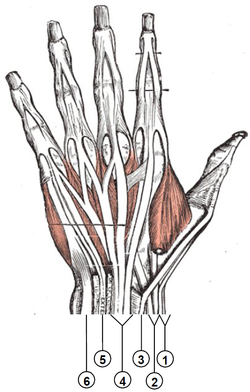| Muscles of the hand | |
|---|---|
 Muscles and other structures of wrist and palm | |
| Details | |
| Origin | Upper extremity |
| Insertion | Hand and fingers |
| Nerve | radial, median, and ulnar nerves (from C5–T1) |
| Actions | Flexion, extension, adduction, abduction of the hand and fingers and oppossion of the thumb |
| Identifiers | |
| FMA | 42368 |
| Anatomical terms of muscle | |
The muscles of the hand are the skeletal muscles responsible for the movement of the hand and fingers. The muscles of the hand can be subdivided into two groups: the extrinsic and intrinsic muscle groups. The extrinsic muscle groups are the long flexors and extensors. They are called extrinsic because the muscle belly is located on the forearm. The intrinsic group are the smaller muscles located within the hand itself. The muscles of the hand are innervated by the radial, median, and ulnar nerves from the brachial plexus. [1]
